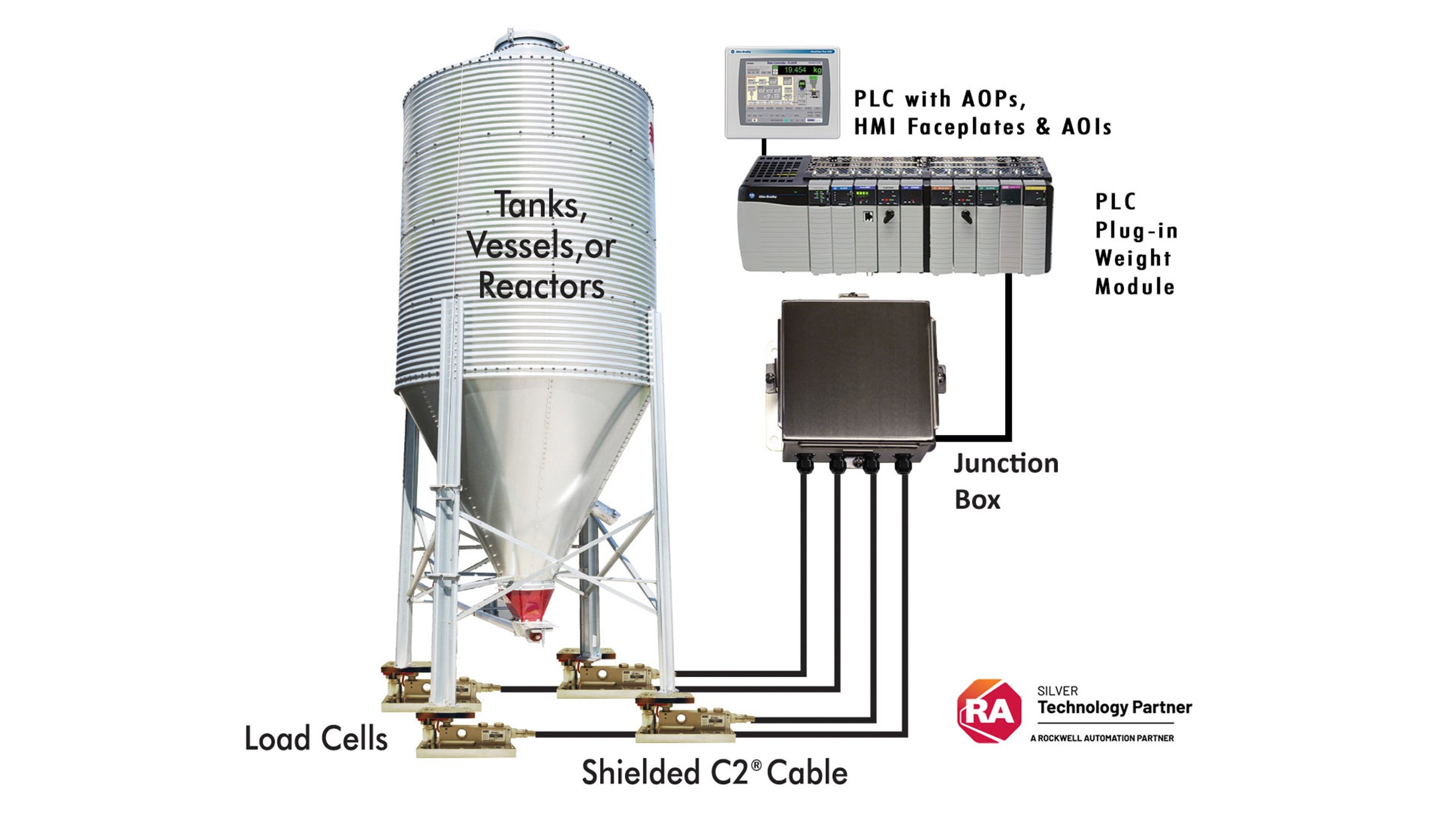The average product gets weighed seven times in the process of going from raw material to finished product. By using tightly integrated PLC backplane plug-in weigh scale modules in manufacturing production systems, businesses can quickly and seamlessly monitor weight, make timely decisions and effectively control their production processes.
PLC weight modules are used in a wide variety of applications such as Inventory Control, Batching/Blending, Filling/Dispensing, Check Weighing, Level by Weight, Rate Control and Rate Monitoring, to name a few. The benefits of these modules include:
- Plugs directly into the backplane-no cabling.
- Generating fast, accurate and deterministic weight data for the PLC/PAC.
- Uses rack I/O for application control.
- Add-On-Profiles ingrained in RSLogix™ in the I/O Configuration menu tree to access set-up and data output functions.
- Tested and validated HMI Faceplates/AOIs for ease of integration with basic weighing functions.
A PLC Plug-In Weight module is only one part of the complete solution. A weighing system can take any of several forms but typically includes one or more load cells that support (or suspend) a weigh vessel or platform, a junction box for summing the load cell signals, and the weight module. Another common application is in feeding or dispensing where material is measured as a loss-in-weight or gain-in-weight operation.
The accuracy of the system’s weight readings can be affected by the system components’ quality and the system’s installation and operation in your manufacturing environment. The objectives are to provide the process with fast, accurate and stable weight readings, with updates fast enough for the process to be controlled effectively. Each scale must be installed, configured, and calibrated quickly and then maintained – recalibrated and issues diagnosed easily.
INSTALLATION - There are many factors to consider in weighing such as the size and type of vessel, support structure, piping (isolation), vibration (movement), and environment (center of gravity, temp, wind, seismic forces), to name a few. For accurate weighing, the load cells alone must support all weight to be measured. You can even hang vessels indoors on the mezzanine level, saving valuable production floor space, with the use of tension load cells.
Hardy installations are up to two times faster with Rockwell Automation® Integration Tools on their silo, tank, platform, and bench scales. These best-in-class Add-On-Profiles (AOPs) and Faceplates/AOIs have all been tested, validated, and documented. Coupled with C2® Calibration and Integrated Technician Diagnostics, installation is up to two times faster, easier and more robust.
CALIBRATION - The Traditional method used to calibrate and validate industrial scales can be very time consuming, costly, disruptive to production and/or place employees and the manufacturing supply chain at some risk. Usually, the higher the capacity of the scale, the greater the impact to production lines. Some companies could be forced or elect to compromise the calibration and complete calibrations with a SPAN load less than the 80% of capacity, thereby deviating from the guidelines laid out for “best weighing practices”. The Traditional process usually takes a long time (hours). The larger the scale the longer it takes (hours and hours). This can drive production (OEE) down and costs up.
Hardy’s C2 “on-site weightless calibration” method approaches the problem by loading each load cell from 0% to 100% with NIST certified test weights at the time of manufacturing. Doing this step captures the characteristics (mV/V/ohm) of each load cell and compensates for its output characteristics. Every load cell manufactured is identical (electrically matched). The calibration characteristics are embedded in a chip in the load cell for use at the customer’s manufacturing facility. The PLC Plug-in Weight Module reads this chip and is calibrated to relate a sensor signal to a weight value.
The whole scale can be calibrated and validated with only a small verification weight of 5% to 10% loaded for “validation.”. This is not a unique technique. This method of pre-calibrating the sensors is also used, for example, in smart pressure sensors.
VIBRATION - To weigh a vessel as accurately as possible, it must be entirely supported by load cells with associated mounting hardware. If the vessel has an associated mixer or agitator that causes vibration, the Plug-In Weigh Scale Module must exclude (separate and eliminate) the vibration information from the weight reading. In most weighing systems, instruments use averaging to reduce the effects of vibration. This can dramatically reduce the update rate, slowing the whole system down. Hardy’s WAVERSAVER® uses a proprietary algorithm that separates and eliminates vibration data from weight data, making the system both faster and more accurate with no decrease in cycle times. Weight readings are both fast and accurate.
DIAGNOSTICS – Troubleshooting a weighing system can be time consuming. Often the components are out of reach or installed in enclosures that require specialized tools to open. If the load cells must be individually unplugged, checked and retested, the integrity of the whole system can be compromised.


